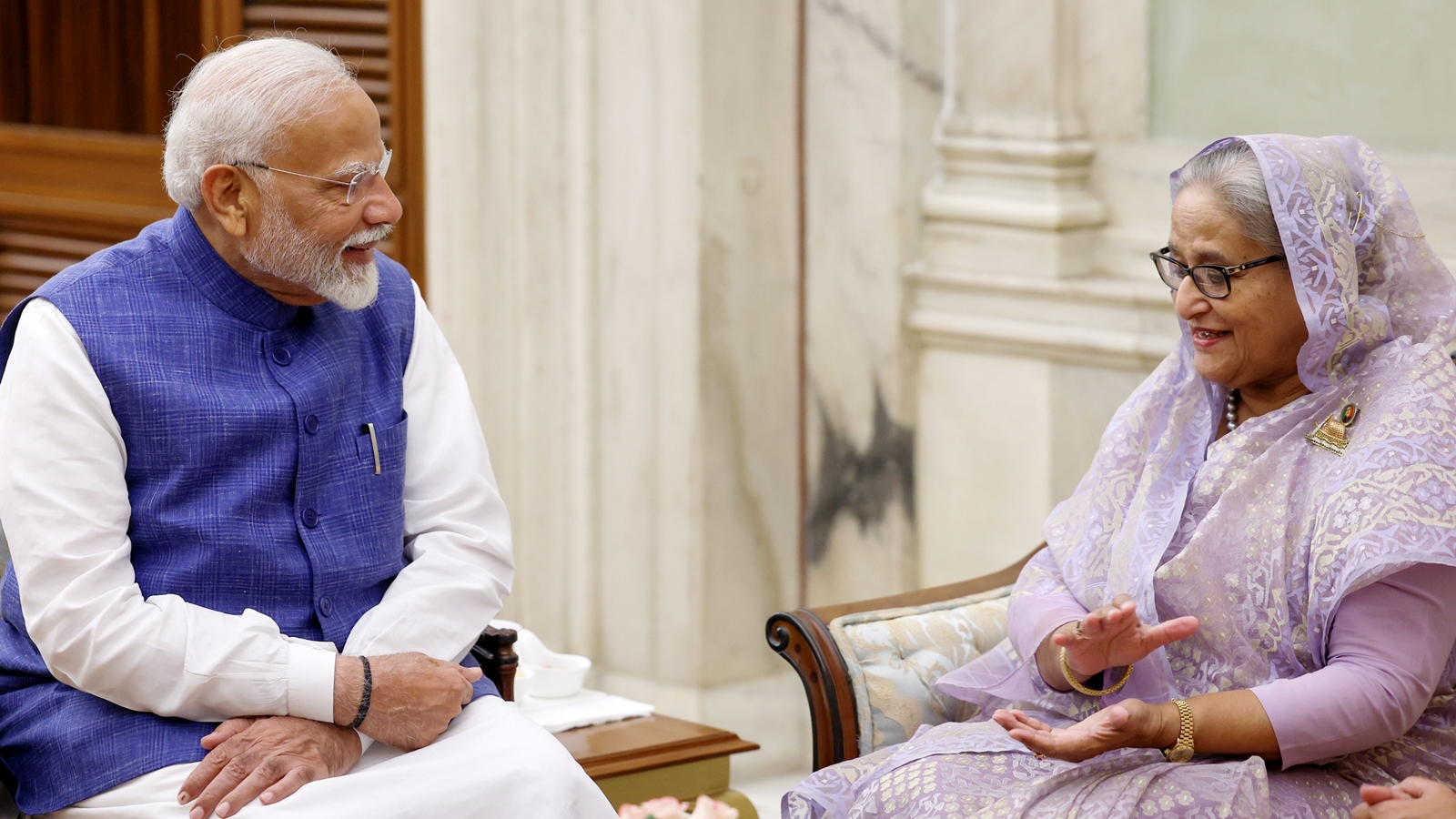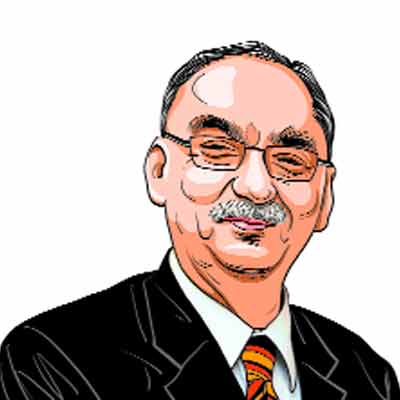Opinion In Modi 3.0, why PM’s tete-a-tete with foreign leaders after his oath-taking ceremony marked a crucial departure
While on the two previous occasions Modi met many of them individually the day after his swearing-in, this time he did not. Opportunity for visiting leaders to hear directly from him on how India wishes to address issues in each bilateral relationship was lost
 President Droupadi Murmu, Vice President Jagdeep Dhankhar, Prime Minister Narendra Modi, Prime Minister of Mauritius Pravind Kumar Jugnauth, Prime Minister of Nepal Pushpa Kamal Dahal, Bangladesh's Prime Minister Sheikh Hasina, President of Sri Lanka Ranil Wickremesinghe, Maldives President Mohammad Muizzu, Prime Minister of Bhutan Tshering Tobgay during the swearing-in ceremony of new Union government. (PTI)
President Droupadi Murmu, Vice President Jagdeep Dhankhar, Prime Minister Narendra Modi, Prime Minister of Mauritius Pravind Kumar Jugnauth, Prime Minister of Nepal Pushpa Kamal Dahal, Bangladesh's Prime Minister Sheikh Hasina, President of Sri Lanka Ranil Wickremesinghe, Maldives President Mohammad Muizzu, Prime Minister of Bhutan Tshering Tobgay during the swearing-in ceremony of new Union government. (PTI) The failure to secure a clear majority by the Bharatiya Janata Party (BJP) in the recent Lok Sabha elections perhaps compelled Prime Minister Narendra Modi to depart from the practice he had followed in 2014 and 2019 regarding his interactions with foreign leaders who attended his oath-taking ceremony. While on the two previous occasions Modi met many visiting leaders individually on the day after his swearing-in, this time around he did not. It is unclear what he did on May 10, but ministerial portfolios were announced that evening. Modi met the visiting leaders on May 9 evening and interacted with them in a tete-e-tete format. The Ministry of External Affairs (MEA) also put out only one collective statement of all the meetings instead of separate government statements on each individual meeting as in 2014 and 2019.
Modi’s oath-taking ceremony was attended by the Presidents of Maldives and Sri Lanka, the Vice-President of Seychelles and the Prime Ministers of Bangladesh, Bhutan, Mauritius and Nepal. The invitation extended to them was in keeping with the tradition that Modi had begun in 2014 when he became the first Indian Prime Minister-designate to invite foreign leaders to his swearing-in. On that occasion, his emphasis was on the SAARC leaders and the Mauritius Prime Minister. Consequently, Afghan President Hamid Karzai also attended the swearing-in ceremony. Significantly, Pakistan Prime Minister Nawaz Sharif decided to accept Modi’s invitation and participate in the ceremony even though the Pakistani generals were unhappy with his decision. At their meeting, the two decided to move bilateral relations towards normalisation though the relationship did not achieve what they had envisaged. Thus, in 2014 the invitations served a substantial purpose.
The 2019 election was held in the shadow of the Pulwama terrorist attack and Modi’s vigorous response through the Balakot airstrike. It was, therefore, impossible for him to invite the then Pakistan Prime Minister Imran Khan. He asked leaders of the Bay of Bengal Initiative for Multi-Sectoral Technical and Economic Cooperation (BIMSTEC) and Kyrgyzstan to his swearing-in. He met many of the invited leaders “bilaterally” in a regular meeting format. Thus, the media note dated May 31, 2019 of Modi’s meeting with Bhutan PM Dr Lotay Tshering stated inter alia, “In the bilateral meeting today, Prime Minister Dr Lotay Tshering congratulated Prime Minister Modi for his re-assumption of office following an emphatic victory in the recently concluded general elections in India”. It went on to add, “He [Modi] conveyed that India deeply values its development partnership, including co-operation in the hydro-power sector with Bhutan”. Similar media notes were issued on Modi’s meetings with other leaders he met on May 31. The main point is that “regular bilateral meetings” were held with the invited guests unless the guest had chosen to leave before such a meeting could be held.
The omnibus media note issued by the Ministry of External Affairs on May 9 on Modi’s interaction with the leaders of the seven invited countries focuses not on his vision for each bilateral relationship but for the region and the Global South. For the former, it states that Modi “reaffirmed India’s commitment to its ‘Neighbourhood First’ policy and SAGAR Vision”. There can be no quarrel with this but by abandoning the 2014 and 2019 format, the opportunity for the visiting leaders to hear, in some detail, from Modi directly at the beginning of his third term on how India wishes to address issues in each bilateral relationship was lost. And, India does have concerns on emerging situations in each neighbour.
 Prime Minister Narendra Modi with Bangladesh PM Sheikh Hasina during a meeting after his swearing-in ceremony. (PTI)
Prime Minister Narendra Modi with Bangladesh PM Sheikh Hasina during a meeting after his swearing-in ceremony. (PTI)
India-Nepal ties are in a sensitive phase. India has security concerns arising from the nature of cooperation that China wishes to thrust on Nepal. The potential of bilateral cooperation has to be given a fresh direction too. Bhutan is undergoing internal transitions and Indian non-interference in these, while strengthening traditional ties, has to continue. India-Bangladesh relations have to be taken to new levels including in the area of connectivity. India handled the Sri Lanka crisis in 2022 deftly. Its assistance was crucial at that stage to stabilise its economic situation. Now, presidential elections are due in autumn and India should not interfere, but it has stakes in Sri Lanka’s stability.
There was a need to have a full and candid discussion with Maldives President Mohamed Muizzu. India has security interests in Maldives which it must pursue. Muizzu’s current approach of aligning Maldives’ interests with China cannot be acceptable to India. Mauritius and Seychelles, too, are vital for India’s position in the Indian Ocean and their leaders should have heard from Modi on how he wishes to continue bilateral engagements.
Indian diplomats and the political leadership would also be acutely aware of the inroads being made by China in India’s neighbourhood and its push in the Indian Ocean region. At such a time, it was especially important for the visiting leaders to have regular bilateral meetings with Modi to hear his views. That would have given his interactions with them substantive content. This would have also prevented from unwittingly giving out an impression of indifference or a higher position in the pecking order of the international community to smaller neighbours. Tete-e-tete formats, especially when these leaders had come to honour him, are liable to be misunderstood. This is so even if External Affairs Minister S Jaishankar called on them and they all had individual and structured meetings with President Droupadi Murmu.
It would, therefore, have been preferable to observe the 2014 and 2019 meetings format. Surely, a few hours could have been found in Modi’s schedule on May 10 for this purpose.
The writer is a former diplomat





